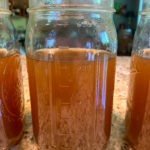Vegetable Broth from Scraps

Vegetable stock is a wonderful ingredient to have on hand in your pantry, fridge, or freezer. You can easily make a flavorful soup or stew with a great veggie stock by simply adding some chopped vegetables and grains, or any other delicious things you have available. Speaking of grains, rice, quinoa, and others climb to a new level when you cook them in stock rather than water, full of vegetable flavor! And stock is perfect for oil-free sauté, imparting more flavor than just using water.
While you can buy vegetable stock, it is very simple to make, especially if you use vegetable scraps. Making your own not only tastes better, but it’s more sustainable as well. No more cans or tetra pak containers to go into the recycling or garbage, and you give vegetable scraps a use before sending them to the compost. Scraps, peels, stems, and cores are full of flavor and, in the case of peels, often contain more antioxidants and phytonutrients than rest of the vegetable!
Not only does homemade stock taste better, you control what is in your food. There’s no oil, no animal products, and no added chemicals. Cans of vegetable broth can be lined with BPA or BPS, and those tetra pak boxes are made of plastic. Chemicals in packaging can leech into your foods, especially liquids, and cause hormone disruption, so it’s best to avoid that. You can learn more ways to keep your food safe from unwanted chemicals in my upcoming online class, Avoiding Environmental Chemicals. Using your own vegetable broth is just one easy thing we’ll cover!
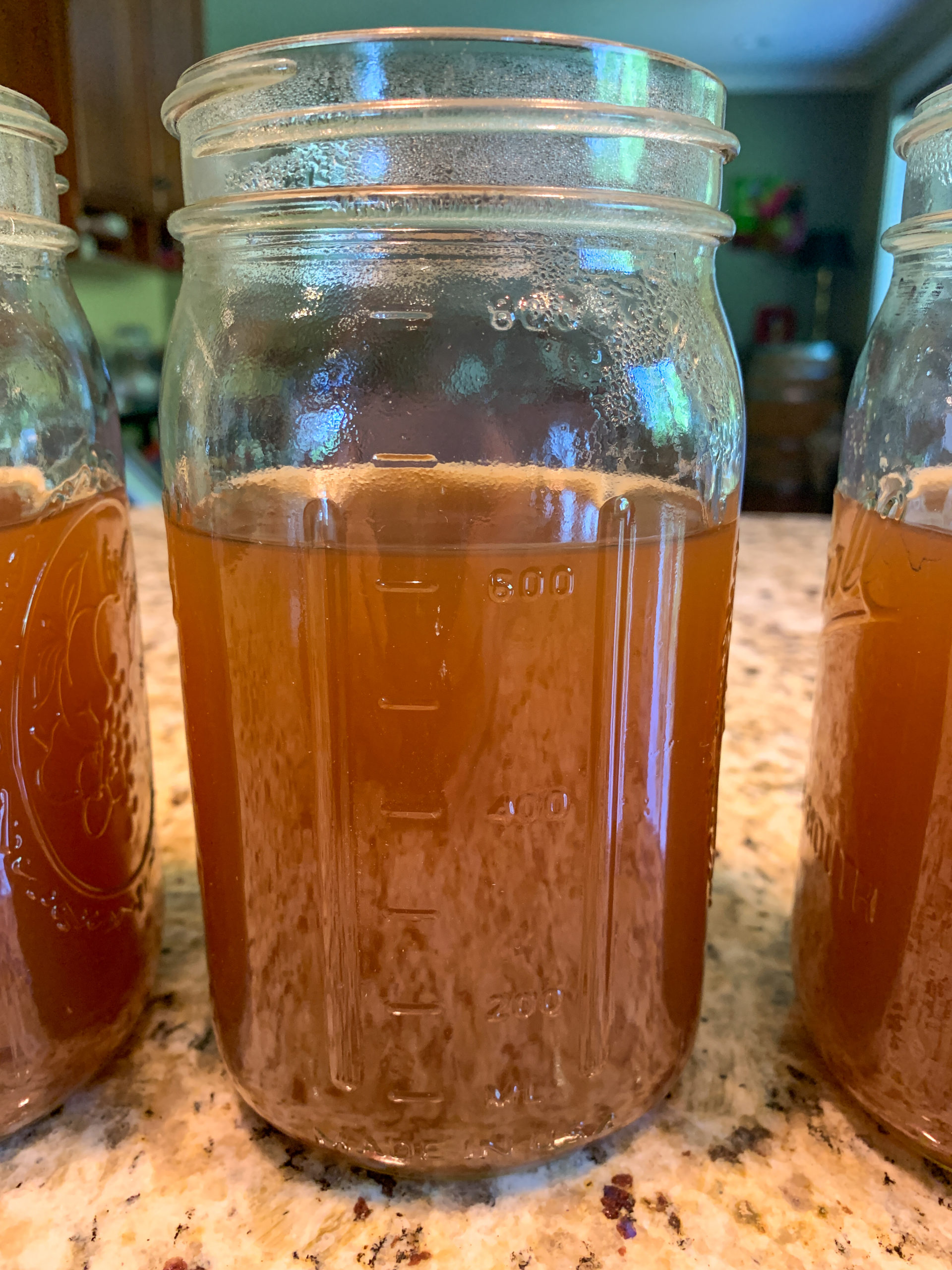
Nothing beats homemade—for taste, price, or safety!
Two years ago I wrote a post on canning vegetable stock, but making it in a stock pot on your stove or in an Instant Pot to refrigerate or freeze is very quick and easy. No special canning equipment is necessary!
As I prepare vegetables, I simply save all scraps that are edible, clean, and not spoiled. I scrub carrots and save the peels and I also wash and save the carrot greens too. Same with potato peels, winter squash seeds and rinds, corn cobs (ones I cut the kernels off of with a knife), garlic and onion skins, and stems from greens. Mushroom stems and woody ends of asparagus are great too. Herb stems, like rosemary, thyme, basil, etc., are wonderful, full of flavor, so I always save those for stock.
I save these scraps in a bowl while I’m prepping to cook and put that bowl in my fridge if I’m going to make a batch of stock in the next day or so. If I don’t have enough scraps for a full batch or if I’m not planning to make stock for a while, I put that bowl of scraps into my freezer. I can pull that frozen bowl out the next time I’m prepping veggies and add to it or make a batch of stock when it’s full.
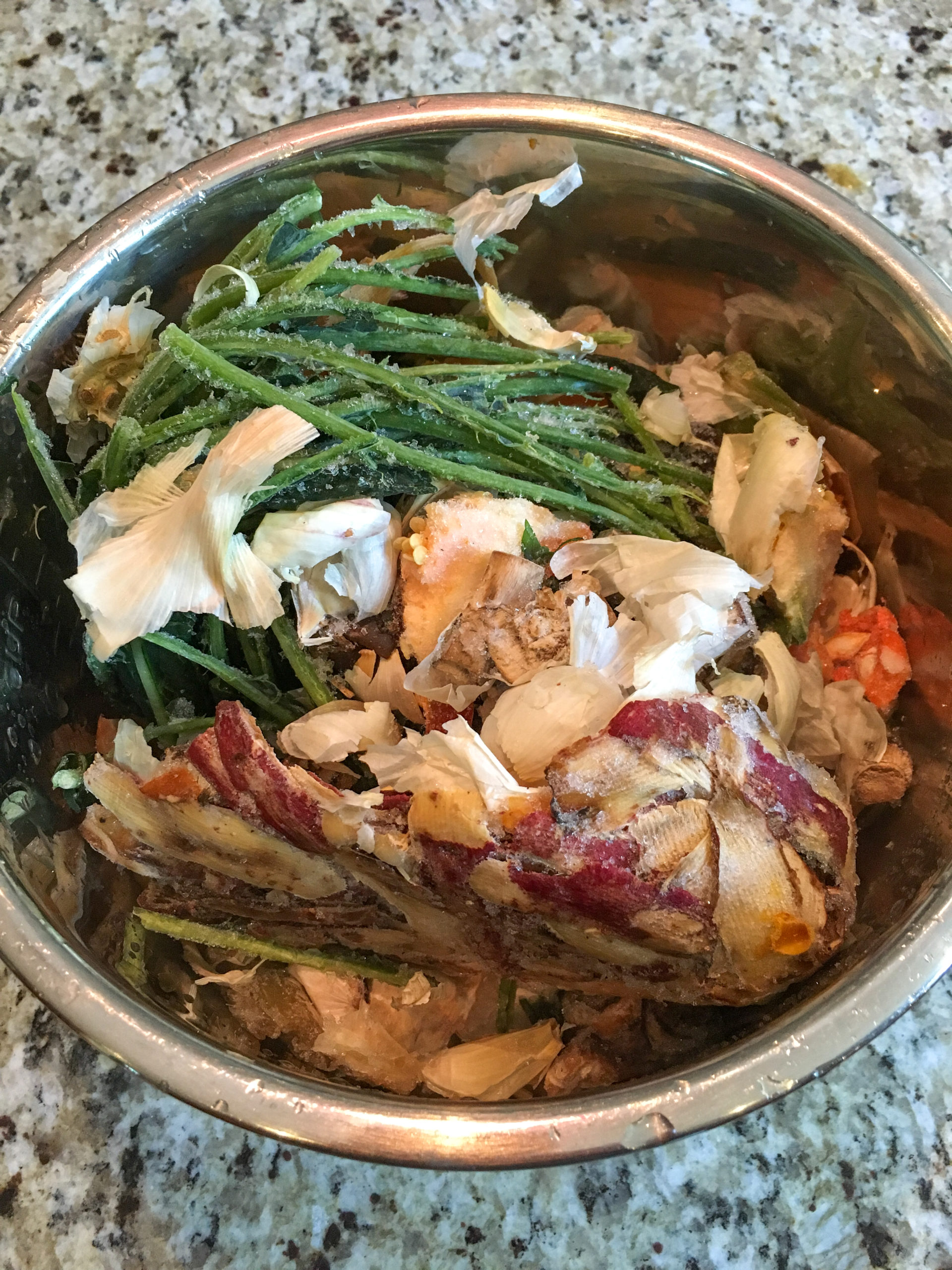
Save those vegetable scraps! These are some I froze to use later.
You’ll see lists of veggies people don’t like to use in their stock, but I don’t have a lot of limitations. Strong colored or flavored vegetables will affect your final stock color and flavor, so that can be a consideration. However, I don’t mind a red stock from some added purple cabbage cores or beet peels! I use the ends of eggplant and broccoli stems, which can flavor your stock to those vegetables, but we like those. Sometimes I’ll add specific herbs and spices to my stock if I’m looking for a particular flavor profile. Adding garlic and cilantro makes a great Mexican stock base while basil, cilantro, and ginger peels are great for an Asian broth.
Making Scrap Stock
Using the Instant Pot or Other Electric Pressure Cooker

10 minutes in your Instant Pot will do it!
An Instant Pot is a fantastic tool for making stock. I simply dump the scraps (frozen or fresh) into the Instant Pot and top with hot water to below the Max Fill line. Then put on the top, align the valve to pressure, and set Manual pressure for 10 minutes. You can do a rapid or natural pressure release when it’s done, doesn’t matter. All in all, it takes about 30-45 minutes, depending on how solid the mass of veggie scraps are and if they’re frozen or not.
On the Stovetop
If you don’t have an electric pressure cooker, don’t fret! You can do the same thing in a stockpot. Put your scraps, fresh or frozen, in a pot, top with water, cover, and bring to a boil. Once boiling, reduce heat and let simmer 30-45 minutes.
Storing Your Stock
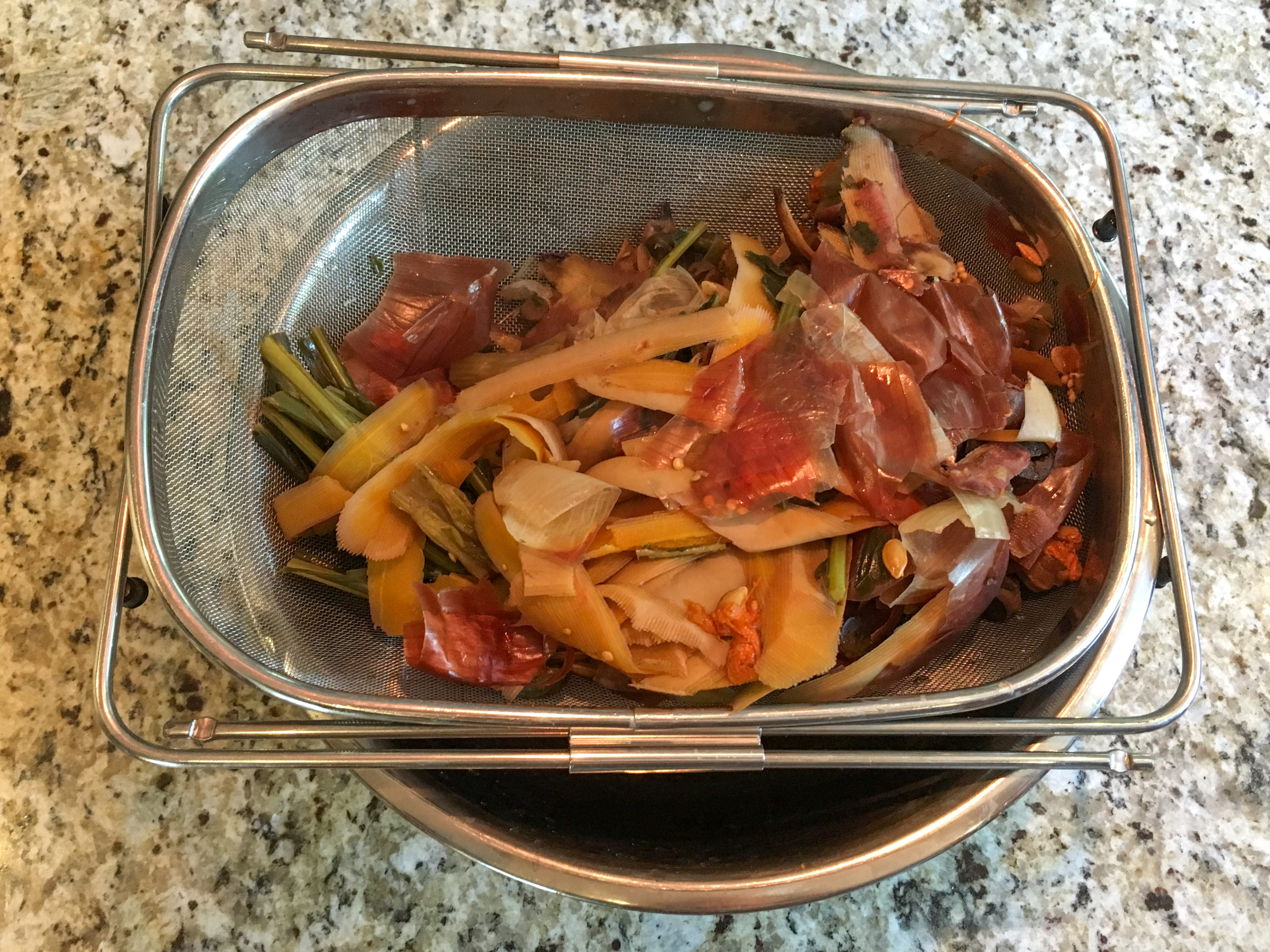
Strain off the solids and discard (compost).
Simply strain off the solids when the stock is done. I like to freeze my stock in quart wide-mouth canning jars, a handy size. However, you have to be careful and not fill them all the way to the top as the jars will crack when the stock expands while freezing. Fill them just below the shoulder of the jar, where the jar starts to slope inward for the neck. This is about 600 mL or 22 fl. oz. in a quart jar, as you can see below:

Nothing beats homemade—for taste or price!
Wait until the stock is cool before putting the jars into your refrigerator or freezer. Fresh stock will last 4-5 days in your refrigerator. You can keep stock for 6 months in your freezer.
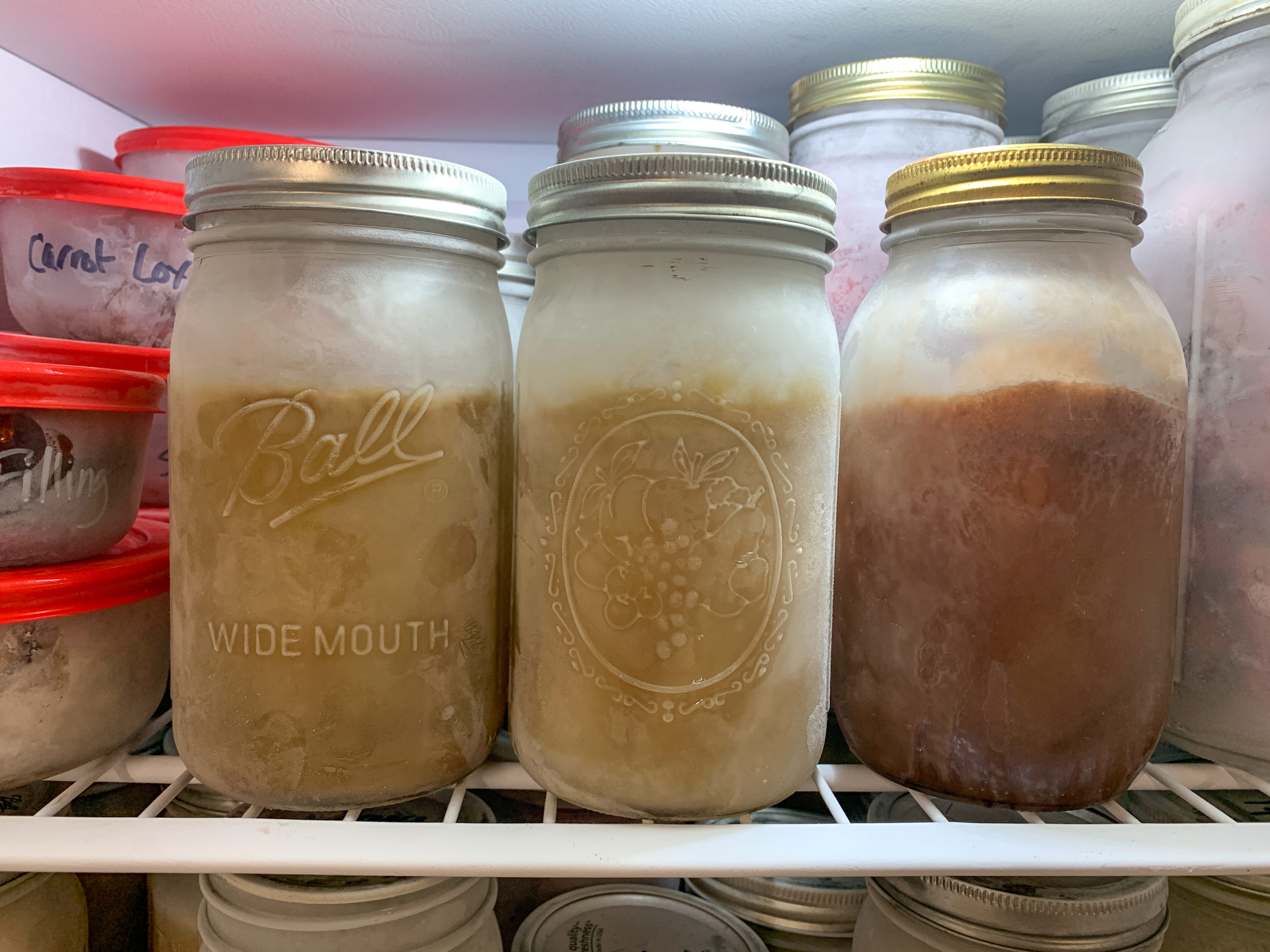
Stock in my freezer (different colors from different veggies!)
To thaw, move from freezer to refrigerator and allow to defrost, usually overnight. You can also remove the metal band and lid and pop the frozen jar into the microwave for 5-10 minutes. I like to top the jar off with water when thawing so I have a full quart of stock—it doesn’t seem to dilute the quality at all.
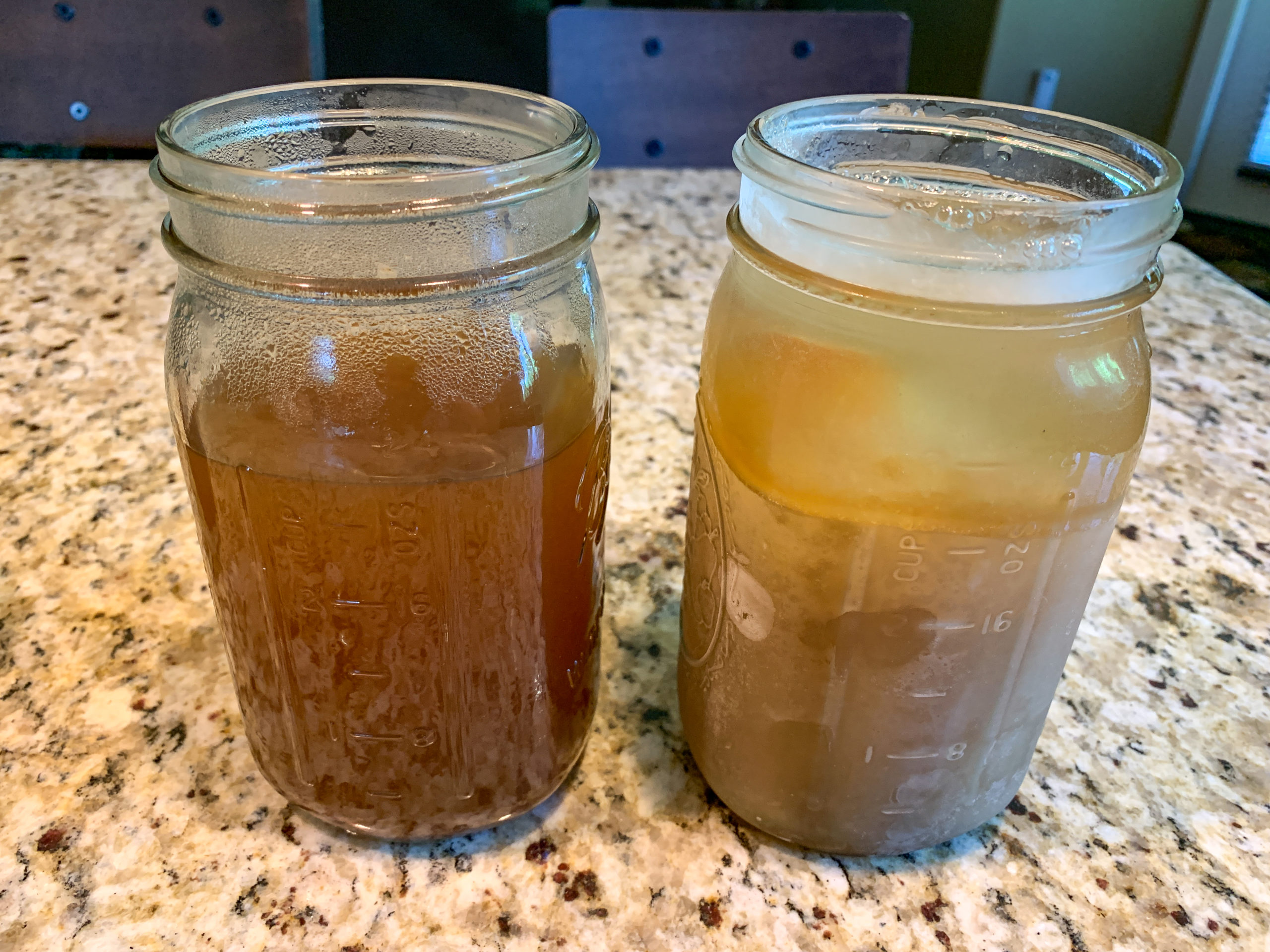
Thawed in microwave (left). Water added to frozen stock (right) when thawing for a full quart.
Vegetable scrap stock is an easy way to incorporate zero waste into your kitchen. And to control what is in your food! Nothing beats homemade vegetable scrap stock. I hope you try it.
If you’re looking for more ways to keep unwanted chemicals out of your family’s food, then don’t miss my Avoiding Environmental Chemicals class where you’ll get more great tips and recipes!
Vegetable Scrap Stock
Ingredients
- 2 quarts vegetable scraps from various vegetables and herbs
- 4 quarts water to fill stock pot or Instant Pot (amount varies)
Instructions
- Add vegetable and herb scraps to large stock pot or Instant Pot. These can be fresh or frozen.
- Add water to cover. If using an Instant Pot, don't fill over the Max Fill line.
- If using an Instant Pot or other electric pressure cooker, set for 10 minutes at high pressure. Can do a quick or natural pressure release at the end. If using a stock pot, cover, bring to a boil, and then reduce heat to simmer 30-45 minutes.
- Strain off solids.
- Pour into containers and allow to cool before putting in the refrigerator or freezer. Use freezer-safe containers if freezing.
Notes
Nutrition
Do you like this post? Please share....
[mashshare]
If you liked this post, you might like one of these:
Categories:
Tags:

[Trī-māz-ing]
Cindy wants you to be Trimazing—three times better than amazing! After improving her health and fitness through plant-based nutrition, losing 60 pounds and becoming an adult-onset athlete, she retired from her 20-year firefighting career to help people just like you. She works with people and organizations so they can reach their health and wellness goals.
Cindy Thompson is a national board-certified Health and Wellness Coach, Lifestyle Medicine Coach, Master Vegan Lifestyle Coach and Educator, Fitness Nutrition Specialist, Behavior Change Specialist, and Fit2Thrive Firefighter Peer Fitness Trainer. She is a Food for Life Instructor with the Physicians Committee for Responsible Medicine, Rouxbe Plant-Based Professional, and Harvard Medical School Culinary Coach, teaching people how to prepare delicious, satisfying, and health-promoting meals.
She provides health and lifestyle coaching at Trimazing! Health & Lifestyle Coaching. Cindy can be reached at info@trimazing.com.
Subscribe to the Trimazing Blog
Receive occasional blog posts in your email inbox.
Subscribe to the Trimazing Blog
Receive occasional blog posts in your email inbox.

